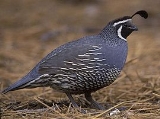
Callipepla
Encyclopedia
Callipepla is a genus of bird
s in the New World quail
family, Odontophoridae.
Bird
Birds are feathered, winged, bipedal, endothermic , egg-laying, vertebrate animals. Around 10,000 living species and 188 families makes them the most speciose class of tetrapod vertebrates. They inhabit ecosystems across the globe, from the Arctic to the Antarctic. Extant birds range in size from...
s in the New World quail
New World quail
The New World quails or Odontophorids are small birds only distantly related to the Old World Quails, but named for their similar appearance and habits. The American species are in their own family Odontophoridae, whereas Old World Quail are in the pheasant family Phasianidae...
family, Odontophoridae.
Species
- Callipepla californicaCalifornia QuailThe California Quail, Callipepla californica, also known as the California Valley Quail or Valley Quail, is a small ground-dwelling bird in the New World quail family...
(Shaw, 1798) – California Quail - Callipepla douglasiiElegant QuailThe Elegant Quail is a species of New World Quail endemic to Pacific-slope thornforest of northwestern Mexico, from southern Sonora to Nayarit.-References:* BirdLife International, 2011. . Accessed on July 16, 2011....
(Vigors, 1829) – Elegant Quail - Callipepla gambeliiGambel's QuailThe Gambel's Quail, Callipepla gambelii, is a small ground-dwelling bird in the New World quail family. It inhabits the desert regions of Arizona, California, Colorado, New Mexico, Nevada, Utah, Texas, and Sonora; also New Mexico-border Chihuahua and the Colorado River region of Baja California...
(Gambel, 1843) – Gambel's Quail - Callipepla squamataScaled QuailThe Scaled Quail , also commonly called Blue Quail or cottontop, is a species of the New World quail family. It is a bluish gray bird found in the arid regions of the Southwestern United States to Central Mexico...
(Vigors, 1830) – Scaled Quail

